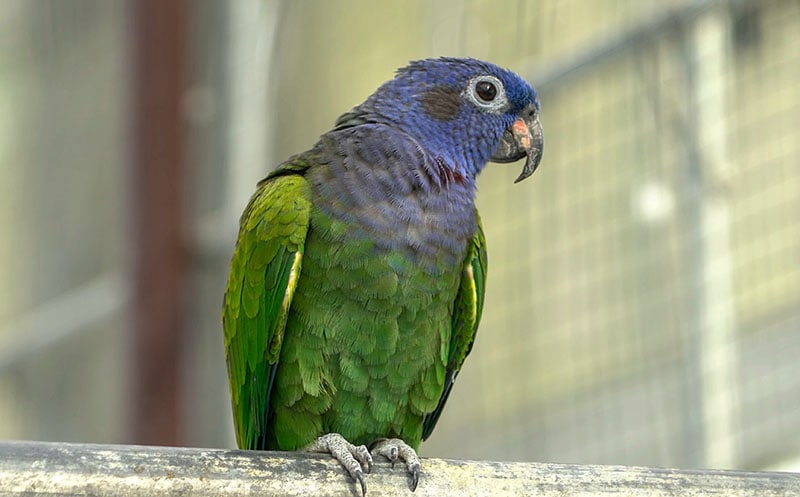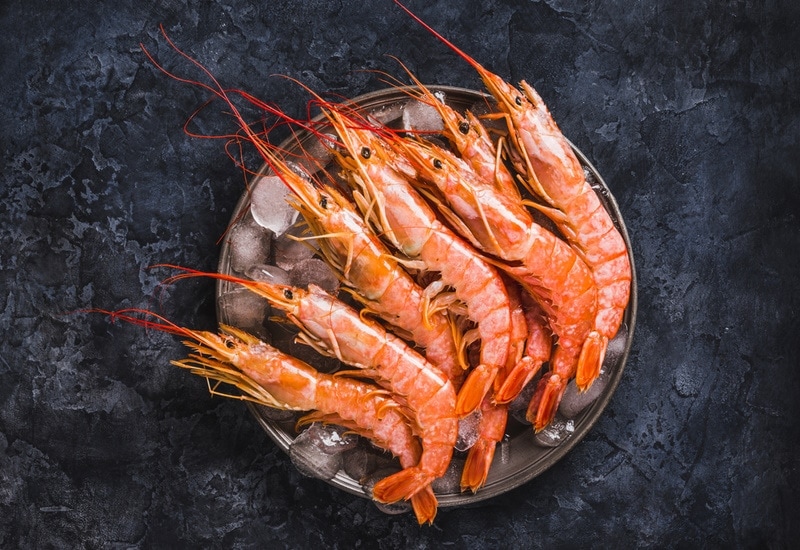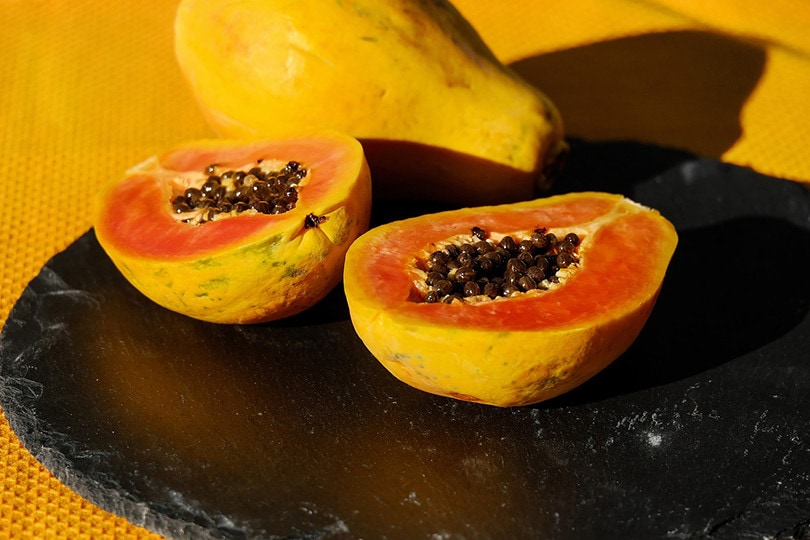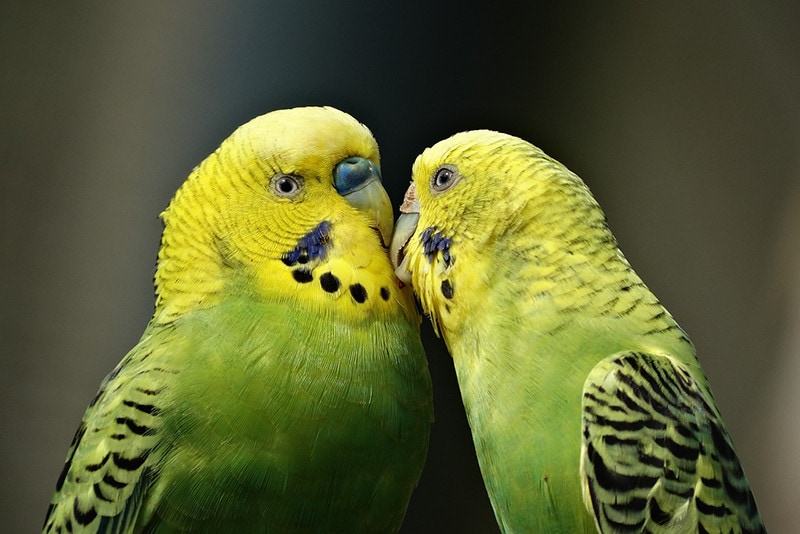Pionus Parrot: Info, Pictures, History, Care, Facts & More
Updated on

Click to Skip Ahead
The name Pionus is the genus of the eight parrot species native to Mexico and Central and South America. The three you’re most likely to see as pets include the blue-headed parrot (Pionus menstruus), the maximillian or scaly-headed parrot (Pionus maximiliani), and the white-capped parrot (Pionus senilis). The coloration varies widely between them, and their descriptive names will tell you which one you have.
These birds differ from other parrots in several ways. The differences are part of what makes them such delightful pets.
Species Overview
| Color: | Blue, green, white, red, or bronze, depending on the species |
| Size: | 9 – 10 inches |
| Weight: | 5 – 6 ounces |
| Wingspan: | 13 – 14 inches |
Even though they live in the same places as other South American parrots, the species of the Pionus genus have vastly different coloration. Traits common among the birds include a short tail, a bare eye ring, and a stocky body. They’re relatively long-lived birds, with a lifespan between 25 and 40 years old. While social in the wild, they are often wary of strangers and prefer the company of their owners.
Pionus Parrot Characteristics
History and Natural Habitat
These birds live in the forests of their native lands, although some species venture into the mountains and savannas. Some of the places they live experience seasonal flooding, prompting them to move with food availability. Regular migration occurs throughout the surrounding islands.
Pionus parrots form small flocks, like many birds. These groups offer protection from predators with safety in numbers. German naturalist Johann Georg Wagler first described species of this genus in 1832. Most species are stable in the wild, with human encroachment not a serious issue in most places. Undoubtedly, their habitat plays a role.

Things to Know When Owning a Pionus Parrot
Temperament
Pionus parrots are gentle birds that can become quite attached to their owner. They’re not as hands-on as other species, yet that doesn’t detract from their sweet nature. Easy-going is a fitting way to describe them. They can be clowns or sweethearts. Some describe them as aloof because they aren’t as welcoming to strangers as they are to their families.
These birds are intelligent, which comes in handy for training and teaching your pet tricks. Pionus parrots are also tricksters that will find things to do and explore if left alone. Daily interaction and enrichment are vital for their mental well-being. This need ties in with their social nature in the wild. Remember that a bored pet can be destructive.
If you’ve had other birds before, you’ll notice it’s a different experience with Pionus parrots. We don’t mean that in a bad way. Other species can be busy and loud, and these birds have their moments, but they can still be a joy to own.

Sounds, Speech & Vocalizations
Pionus parrots aren’t the loud, screeching companion birds like macaws or Amazons. That’s part of their attraction. That’s not to say they don’t vocalize; they just don’t have it turned up to full volume. They can make high-pitched squeals when they’re excited, which can startle you the first time you hear it. Pionus parrots aren’t big talkers, although they may pick up a few words with practice and patience.
Pionus Parrot Appearance
The appearance varies with the species. We mentioned some common denominators with the body shape and eye ring. Green is another prevalent color because of its role in camouflage. It allows the birds to blend in well in their forested habitats. Varying head colors is another shared trait. Think white-crowned parrot and blue-headed parrot. Plumage specifics are as follows:
- Blue-headed parrot: Blue head with a red spot behind the eyes and a mainly green body
- Bronze-winged parrot: Dark blue body with bronze-green wings
- Dusky parrot: Brown-gray body with bluish wings
- Plum-crowned parrot: Mottled wine-colored head and a dull green body
- Red-billed parrot: Mainly green with a red bill and a drab blue chest
- Scaly-headed parrot: Green and dull blue body with dark-tipped feathers that look like scales
- White-crowned parrot: White on the top of their head with a dark blue and green body
Caring for the Pionus Parrot
Caring for any pet is a serious responsibility. Parrots take it to the next level with their long lifespans. Understanding this commitment is imperative. Diet and proper nutrition are challenging with any captive bird. Replicating what Pionus parrots eat in the wild is impractical. The other obstacle is adequate mental stimulation. Life in a cage isn’t easy for an intelligent animal.
Your role as a pet owner is to fill in for the bird’s flock mates. You’ll have to provide the interactions and enrichment they’d get from living in the wild. Therefore, getting a Pionus parrot is also a time commitment, as this companion bird must get attention.
Diet & Nutrition
Proper nutrition comes from eating up to 80 foods in the wild. Interestingly, they manage to handle this aspect well. The solution for captive birds is a pelleted diet. Adults need about 10–14% protein. Seeds may provide energy from fat, but they won’t necessarily meet your pet’s other requirements. For example, nutrient deficiencies are common among avian pets fed seed mixes only.
You should give your Pionus parrot a pelleted diet comprising up to 80% of their daily caloric intake. Fresh fruits and vegetables can provide the rest of their food. These birds eat all kinds of plant parts in the wild, from leaves to flowers. However, some companion birds are wary of new foods without the experience that living in the wild gives them.

Cage/Housing Requirements
We strongly urge you to get the largest cage you can afford for the space you have for it. The chances are your parrot will spend most of their days inside it. You should account for extra room for toys, bowls, perches, and a hiding place.
You should put the cage out of direct sunlight and away from vents. We also suggest getting a cover to put over it. Diurnal species like Pionus parrots usually greet the day with song. That might not be welcome at sunrise, so you can use the cover as part of a daily routine.
Exercise
Playtime outside their cage is critical for the bird’s physical and mental health. Installing a playpen on top of the cage can provide a convenient home base for your pet. We recommend ensuring the room is parrot-proof before giving your bird free rein, especially if your parrot can fly. Their intelligence makes Pionus parrots curious. Sadly, it doesn’t help them avoid hazards like electrical cords.
Interactive toys can provide welcome mental stimulation. However, you’ll likely find that your pet will break the code quickly. Swapping out toys can make the old ones seem new again.

Health & Conditions
You should find a vet specializing in birds before getting one. It can be challenging, depending on where you live. However, it’s better to locate a vet before you need to take your pet because of an emergency. We recommend annual visits to keep your Pionus pet in the best of health.
- Self-destructive behavior
- Vitamin A deficiency
- Aspergillosis
- Vitamin D deficiency
3 Little-Known Facts About the Pionus Parrot
1. The Bird’s Genus Name Is Fitting
The genus Pionus is believed to come from the Greek word “pion”, which, depending on the translation, means “fat.” It’s a fitting descriptor, given the species’ propensity for obesity.

2. The Blue-breasted Parrot (Pionus reichenowi) Is the Only Species Considered Vulnerable in the Wild
According to the International Union for Conservation of Nature and Natural Resources (IUCN), less than 10,000 individuals remain in the wild. The decline of habitat quality is one of the bird’s main threats.
3. There Are 13 Subspecies of Pionus Parrots
While not all species, isolated pockets of birds have justified categorizing some species into subspecies.
Conclusion
Pionus parrots are beautiful birds with plumage that optimizes camouflage in their native lands. Their small size and quieter nature make them a good choice for first-time pet owners. They will reward you with love and affection with daily interaction and play. Understanding the commitment these companion animals involve is essential. However, the benefits are priceless.
Featured Image Credit: Swaroop Pixs, Shutterstock











